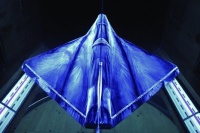Flaviir project trials new forms of wing command
Flapless technology that manipulates airflow could represent a new way to control aircraft.

Flying is the art of controlling the air. If you watch any flying object – insect, bird or aircraft – to see how it flies, you can’t see the most crucial aspect, which is how the air flows around and past the body. It’s this that supplies lift, which keeps the object in the air. The air flow is what allows the object to change direction, to swoop and turn. Thrust alone will get you into the air, but it won’t keep you there. If you want to fly, you have to control the air.
How to do it is a complex matter. Gliders aside, living aeronauts do it by combining their control surfaces with their thrust generators – they flap their wings, move them and change their shape in complex ways that we’re only just beginning to understand and can barely emulate. For man-made flying vehicles, the main way to control the flow of air, and therefore enable true flight, is to change the shape of the wings, with flaps and rudders, to deflect the air as it passes over them.
Register now to continue reading
Thanks for visiting The Engineer. You’ve now reached your monthly limit of premium content. Register for free to unlock unlimited access to all of our premium content, as well as the latest technology news, industry opinion and special reports.
Benefits of registering
-
In-depth insights and coverage of key emerging trends
-
Unrestricted access to special reports throughout the year
-
Daily technology news delivered straight to your inbox










Water Sector Talent Exodus Could Cripple The Sector
Maybe if things are essential for the running of a country and we want to pay a fair price we should be running these utilities on a not for profit...